
HMS Beagle was a Cherokee-class 10-gun brig-sloop of the Royal Navy, one of more than 100 ships of this class. The vessel, constructed at a cost of £7,803, was launched on 11 May 1820 from the Woolwich Dockyard on the River Thames. Later reports say the ship took part in celebrations of the coronation of King George IV of the United Kingdom, passing under the old London Bridge, and was the first rigged man-of-war afloat upriver of the bridge. There was no immediate need for Beagle, so she "lay in ordinary", moored afloat but without masts or rigging. She was then adapted as a survey barque and took part in three survey expeditions.
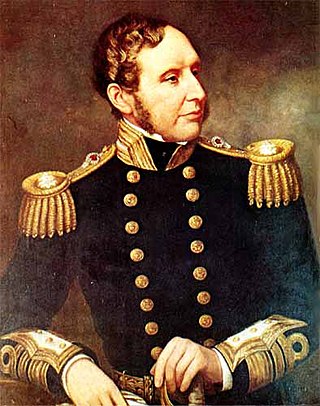
Vice-Admiral Robert FitzRoy was an English officer of the Royal Navy and a scientist. He achieved lasting fame as the captain of HMS Beagle during Charles Darwin's famous voyage, FitzRoy's second expedition to Tierra del Fuego and the Southern Cone.

The Voyage of the Beagle is the title most commonly given to the book written by Charles Darwin and published in 1839 as his Journal and Remarks, bringing him considerable fame and respect. This was the third volume of The Narrative of the Voyages of H.M. Ships Adventure and Beagle, the other volumes of which were written or edited by the commanders of the ships. Journal and Remarks covers Darwin's part in the second survey expedition of the ship HMS Beagle. Due to the popularity of Darwin's account, the publisher reissued it later in 1839 as Darwin's Journal of Researches, and the revised second edition published in 1845 used this title. A republication of the book in 1905 introduced the title The Voyage of the "Beagle", by which it is now best known.

The Falkland Islands wolf, also known as the warrah and occasionally as the Falkland Islands dog, Falkland Islands fox, warrah fox, or Antarctic wolf, was the only native land mammal of the Falkland Islands. This endemic canid became extinct in 1876, the first known canid to have become extinct in historical times.
Beagle is a breed of dog.

East Falkland is the largest island of the Falklands in the South Atlantic, having an area of 6,605 km2 or 54% of the total area of the Falklands. The island consists of two main land masses, of which the more southerly is known as Lafonia; it is joined by a narrow isthmus where the settlement of Goose Green is located, and it was the scene of the Battle of Goose Green during the Falklands War.
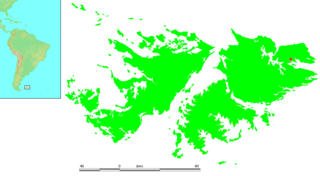
Port Louis is a settlement on northeastern East Falkland. It was established by Louis de Bougainville on 5 April 1764 as the first French settlement on the islands, but was then transferred to Spain in 1767 and renamed Puerto Soledad.

Beagle Channel is a strait in the Tierra del Fuego Archipelago, on the extreme southern tip of South America between Chile and Argentina. The channel separates the larger main island of Isla Grande de Tierra del Fuego from various smaller islands including the islands of Picton, Lennox and Nueva; Navarino; Hoste; Londonderry; and Stewart. The channel's eastern area forms part of the border between Chile and Argentina and the western area is entirely within Chile.

Redmond O'Hanlon FRGS FRSL is an English writer and scholar.
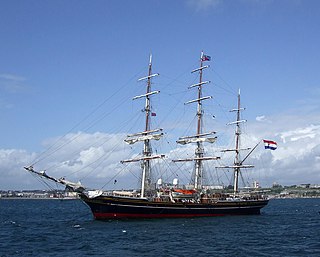
The Stad Amsterdam is a three-masted clipper that was built in Amsterdam, the Netherlands, in 2000 at the Damen Shipyard.

The second voyage of HMS Beagle, from 27 December 1831 to 2 October 1836, was the second survey expedition of HMS Beagle, made under her newest commander, Robert FitzRoy. FitzRoy had thought of the advantages of having someone onboard who could investigate geology, and sought a naturalist to accompany them as a supernumerary. At the age of 22, the graduate Charles Darwin hoped to see the tropics before becoming a parson, and accepted the opportunity. He was greatly influenced by reading Charles Lyell's Principles of Geology during the voyage. By the end of the expedition, Darwin had made his name as a geologist and fossil collector, and the publication of his journal gave him wide renown as a writer.

Falkland Islanders derive from various origins. Earliest among these are the numerically small but internationally diverse early 19th century inhabitants of the Falkland Islands, comprising and descended in part from settlers brought by Luis Vernet, and English and American sealers; South American gauchos who settled in the 1840s and 1850s; and since the late 1830s, settlers largely from Britain with a minority from other European countries. There has also been significant recent contributions from Saint Helena and Chile.
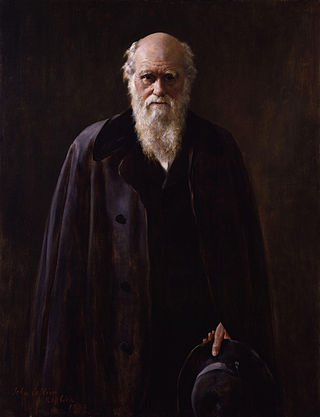
Commemoration of Charles Darwin began with geographical features named after Darwin while he was still on the Beagle survey voyage, continued after his return with the naming of species he had collected, and extended further with his increasing fame. Many geographical features, species and institutions bear his name. Interest in his work has led to scholarship and publications, nicknamed the Darwin Industry, and his life is remembered in fiction, film and TV productions as well as in numerous biographies. Darwin Day has become an annual event, and in 2009 there were worldwide celebrations to mark the bicentenary of Darwin's birth and the 150th anniversary of the publication of On the Origin of Species.

A nautical chronometer made by Thomas Earnshaw (1749–1828), and once part of the equipment of HMS Beagle, the ship that carried Charles Darwin on his voyage around the world, is held in the British Museum. The chronometer was the subject of one episode of the BBC's series A History of the World in 100 Objects.

Sarah Catherine Darwin FLS is a British botanist.
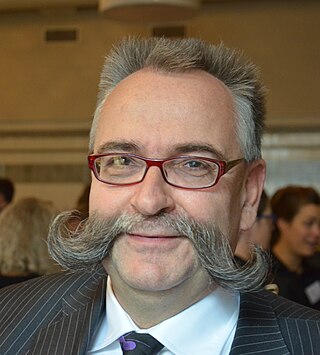
Johannes Christian Vogel FLS FAAAS is a German botanist, who since 1 February 2012 has been Director General of the Museum für Naturkunde and Professor of Biodiversity and Public Science at Humboldt University, both in Berlin. He previously held the post of Keeper of Botany at the Natural History Museum in the United Kingdom from 2004 to 2012.
The Jane Cameron National Archives are the official national archives of the Falkland Islands. Government records in the Falklands were started by the first Governor of the Falkland Islands, Richard Moody, in 1841. The records were initially kept in Stanley Town Hall and the Secretariat Building and remained largely intact, despite fires in 1944 and 1959.
Extracts from Letters to Henslow, taken from ten letters Charles Darwin wrote to John Stevens Henslow from South America during the second survey expedition of HMS Beagle, were read to the Cambridge Philosophical Society on 16 November 1835 by Henslow and Adam Sedgwick, followed on 18 November by geological notes from the letters which Sedgwick read to the Geological Society of London. On 1 December 1835 they were printed as a pamphlet for private distribution.

Anthony Smith is a British sculptor who works in bronze. He is known for his wildlife sculptures as well as his depictions of well-known figures, including Charles Darwin, Ian Fleming, and Alfred Russel Wallace. He has been awarded major public commissions including the design of a new £2 coin for the Royal Mint, the first new statue for London's Natural History Museum in more than eighty years, and a life-sized statue of Charles Darwin for Christ's College, Cambridge. In addition, he is a wildlife photographer.
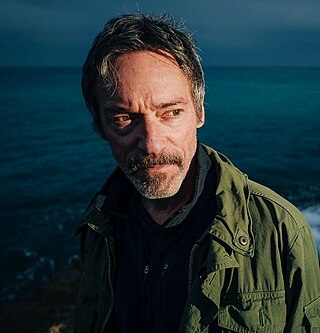
Peter Brayton Nichols is an American author. He is known for authoring bestsellers, “The Rocks,” ; A Voyage for Madmen,, finalist for the William Hill Sports Book of the Year), Evolution's Captain, and several other books. His novel Voyage to the North Star was a Book Of The Month Club Main Selection and nominated for the International IMPAC Dublin Literary Award. He has forthcoming a new thriller with Celadon Books, titled Granite Harbor (2024).

















